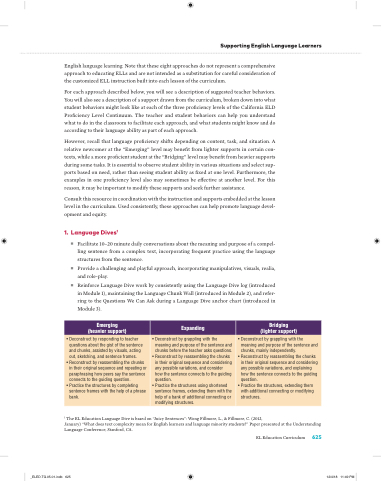Page 649 - EL Grade 5 Teacher Guide
P. 649
Supporting English Language Learners
English language learning. Note that these eight approaches do not represent a comprehensive approach to educating ELLs and are not intended as a substitution for careful consideration of the customized ELL instruction built into each lesson of the curriculum.
For each approach described below, you will see a description of suggested teacher behaviors. You will also see a description of a support drawn from the curriculum, broken down into what student behaviors might look like at each of the three pro ciency levels of the California ELD Pro ciency Level Continuum. The teacher and student behaviors can help you understand what to do in the classroom to facilitate each approach, and what students might know and do according to their language ability as part of each approach.
However, recall that language pro ciency shifts depending on content, task, and situation. A relative newcomer at the “Emerging” level may bene t from lighter supports in certain con- texts, while a more pro cient student at the “Bridging” level may bene t from heavier supports during some tasks. It is essential to observe student ability in various situations and select sup- ports based on need, rather than seeing student ability as xed at one level. Furthermore, the examples in one pro ciency level also may sometimes be e ective at another level. For this reason, it may be important to modify these supports and seek further assistance.
Consult this resource in coordination with the instruction and supports embedded at the lesson level in the curriculum. Used consistently, these approaches can help promote language devel- opment and equity.
1. Language Dives1
■ Facilitate 10–20 minute daily conversations about the meaning and purpose of a compel- ling sentence from a complex text, incorporating frequent practice using the language structures from the sentence.
■ Provide a challenging and playful approach, incorporating manipulatives, visuals, realia, and role-play.
■ Reinforce Language Dive work by consistently using the Language Dive log (introduced in Module 1), maintaining the Language Chunk Wall (introduced in Module 2), and refer- ring to the Questions We Can Ask during a Language Dive anchor chart (introduced in Module 3).
Emerging (heavier support)
Expanding
Bridging (lighter support)
• Deconstruct by responding to teacher questions about the gist of the sentence and chunks, assisted by visuals, acting out, sketching, and sentence frames.
• Reconstruct by reassembling the chunks in their original sequence and repeating or paraphrasing how peers say the sentence connects to the guiding question.
• Practice the structures by completing sentence frames with the help of a phrase bank.
• Deconstruct by grappling with the meaning and purpose of the sentence and chunks before the teacher asks questions.
• Reconstruct by reassembling the chunks in their original sequence and considering any possible variations, and consider how the sentence connects to the guiding question.
• Practice the structures using shortened sentence frames, extending them with the help of a bank of additional connecting or modifying structures.
• Deconstruct by grappling with the meaning and purpose of the sentence and chunks, mainly independently.
• Reconstruct by reassembling the chunks in their original sequence and considering any possible variations, and explaining how the sentence connects to the guiding question.
• Practice the structures, extending them with additional connecting or modifying structures.
1 The EL Education Language Dive is based on “Juicy Sentences”: Wong Fillmore, L., & Fillmore, C. (2012,
January) “What does text complexity mean for English learners and language minority students?” Paper presented at the Understanding Language Conference, Stanford, CA.
EL Education Curriculum 625
_ELED.TG.05.01.indb 625
12/4/18 11:49 PM


